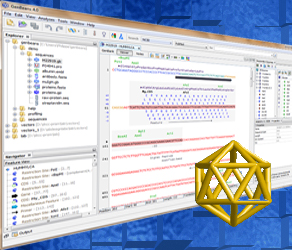ADVERTISEMENT
Subcellular Localization
Databases
eSLDB is a database of protein subcellular localization annotation for eukaryotic organisms. It contains experimental annotations derived from primary protein databases, homology based annotations and computational predictions.
The STEPdb database contains a comprehensive characterization of sub-cellular localization and topology of the Escherichia coli proteome. Current annotation is a result a multi-combinatorial analysis including existing databases, predictions of bioinformatic tools and exhaustive literature survey and manual curation. Tools for sequence similarity searches, prediction of sub-cellular location, visualization of membrane proteins topologies and protein complexes are included.
A database of organelle proteins, and subcellular structures / complexes
LOCATE is a curated database that houses data describing the membrane organization and subcellular localization of proteins from the RIKEN FANTOM4 mouse and human protein sequence set.
LocDB is a expert curated database that collects experimental annotations for the subcellular localization of proteins in Human (Homo sapiens) and Weed (Arabidopsis thaliana).
General Prediction
Predicts the subcellular location of eukaryotic proteins (use results of ChloroP and SignalP). Secretory signal peptides, mitochondrial targeting peptides and chloroplast transit peptides in eukaryotes.
The SecretomeP 2.0 server produces ab initio predictions of non-classical i.e. not signal peptide triggered protein secretion. The method queries a large number of other feature prediction servers to obtain information on various post-translational and localizational aspects of the protein, which are integrated into the final secretion prediction.
Events News Research CBS CBS Publications Bioinformatics
Staff Contact About Internal CBS CBS Other
CBS >> CBS Prediction Servers >> TatP
TatP 1.0 Server
TatP 1.0 server predicts the presence and location of Twin-arginine signal peptide cleavage sites in bacteria. The method incorporates a prediction of cleavage sites and a signal peptide/non-signal peptide prediction based on a combination of two artificial neural networks.
BaCelLo is a predictor for the subcellular localization of proteins in eukaryotes. It is based on a decision tree of several support vector machines (SVMs), it classifies up to four localizations for Fungi and Metazoan proteins and five localizations for Plant ones
Subcellular Localisation Predictor (locations in plants and in other eukaryotes (TargetP data))..
Subcellular localization predictor; CELLO is a multi-class SVM classification system.
The Proteome Analyst Specialized Subcellular Localization Server (PA-SUB) is part of Proteome Analyst (PA). PA is a web server built to predict protein properties, such as general function, in a high-throughput fashion. PA-SUB is specialized to predict the subcellular localization of proteins using established machine learning techniques.
Subcellular location in plants, other eukaryotes, fungi.
PSLpred is a SVM based method to predict 5 major subcelullar localization (cytoplam, inner-membrane, outermembrane, extracellular, and periplasm) of Gram-negative bacteria.
pTARGET is a computational method to predict the subcellular localization of only eukaryotic proteins from animal species that include fungi and metazoans. Predictions are carried out based on the occurrence patterns of protein functional domains and the amino acid compositional differences in proteins from different subcellular locations. This method can predict proteins targeted to nine distinct subcellular locations that include cytoplasm, endoplasmic reticulum, extracellular/secreted, Golgi, lysosomes, mitochondria, nucleus, peroxysomes and plasma membrane.
Protein terminii
ProTeus (PROtein TErminUS) is a tool for identification of short linear signatures in protein termini. It is based on a positional-based search method for revealing short significant signatures in termini of proteins.
Signal Peptides
SignalP 4.1 server predicts the presence and location of signal peptide cleavage sites in amino acid sequences from different organisms: Gram-positive prokaryotes, Gram-negative prokaryotes, and eukaryotes. The method incorporates a prediction of cleavage sites and a signal peptide/non-signal peptide prediction based on a combination of several artificial neural networks and hidden Markov models.
PrediSi (PREDIction of SIgnal peptides) is a software tool for predicting signal peptide sequences and their cleavage positions in bacterial and eukaryotic proteins.
Signal-3L is an automated method for predicting signal peptide sequences and their cleavage sites in eukaryotic and bacterial protein sequences that uses a 3-layer approach for predicting signal peptides.
Online tool to find and list homologies of published signal sequences with the input DNA sequence.
450 Signal Sequences of E. coli Cell Envelope Proteins compilated by ECCE (The E. coli Cell Envelope Protein Data Collection)
iPSORT is a subcellular localization site predictor for N-terminal sorting signals. Given a protein sequence , it will predict whether it contains a Signal Peptide (SP), Mitochondrial Targeting Peptide (mTP), or Chloroplast Transit Peptide (cTP).
High performance system for signal peptide prediction.
Mitochondrial & ER Localization
MITOPROT: Prediction of mitochondrial targeting sequences
Prediction of N-terminal sequence for mitochondrial, plastid and ER targeting sequences
Choroplast localization
Golgi Localization
Prediction of Golgi Type II membrane proteins based on their transmembrane domains.
Lipoprotein Signal Peptides
Prediction of lipoproteins and signal peptides in Gram negative bacteria.
Prediction of Lipoprotein and Secretory Signal Peptides in Gram-positive Bacteria with Hidden Markov Models.
Peroxisomal Targeting Signals
Nuclear Localization
NetNES 1.1 server predicts leucine-rich nuclear export signals (NES) in eukaryotic proteins using a combination of neural networks and hidden Markov models.
GPI-Anchor Prediction
GPI lipid anchor predictor in plants
GPI lipid anchor predictor in fungi
The Web Bench
The Web Bench
is the essential companion to the biologist, bringing informational resources and a collection of tools & calculators to facilitate work at the bench and analysis of biological data.
Check out the full online bench here
Check out the full online bench here
Sequence Analysis with GenBeans
 Try GenBeans: Best free software for DNA sequence editing!
Try GenBeans: Best free software for DNA sequence editing!
FEEDBACK
Your comments & your suggestionsare appreciated. Please, notify us for resources and tools that you would like to see on this bench!





